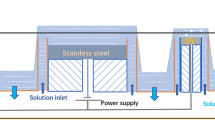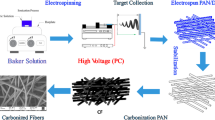Abstract
Type II carbon fibres (PAN-based) have been electrochemically oxidized in aqueous potassium nitrate to varying electron charge densities (0–4294 Cg-1). The fibres were subsequently characterized by angle-resolved X-ray photoelectron spectroscopy (ARXPS) and ion scattering spectroscopy (ISS) and the results were correlated to acid/base surface titrations and BET surface area measurements. Relative to the as-received fibres (commercially treated, but unsized), the electrochemical treatments increased the ARXPS O/C atomic ratios by approximately 50%–100% and the concentration of oxidized carbon became more uniform within the XPS sampling depth (≈10 nm). At the same time, the number of acidic functions titrated by sodium hydroxide rose from about 2.6 μeq g-1 to 1078 μeq g-1, and the BET surface area increased from 0.67 m2 g-1 to 2.9 m2 g-1. A large portion of the increase in acidic groups was due to the increased fibre oxidation below the XPS sampling depth. The surface densities of acidic functions (functions/nm2) determined from NaOH uptake and nitrogen BET surface area experiments were far larger than is physically possible. Thus, it is postulated that aqueous NaOH solutions are able to access a much larger surface region than can be measured by nitrogen BET. A model involving subsurface pores, voids, crevasses, etc., which become available via swelling during solvation in aqueous NaOH, but are at least partially closed off when dry (during BET measurements), was proposed. The quantity of acidic functions introduced (detected by NaOH) was directly proportional to the extent of oxidation as referenced to the electron charge density (C g-1). The ISS spectra suggest that the surface density of carbon/oxygen groups was also increased. Single-fibre fragmentation tests (using an epoxy resin matrix) revealed that in most cases the interfacial shear strengths (IFSS) increased with increasing ARXPS O/C atomic ratio probably due to enhanced fibre/matrix chemical bonding and/or mechanical interlocking. As the extent of the electrochemical oxidation progressed above 1500 C g-1 the IFSS of single filament specimens then began to decrease. This was due to a continuing decrease in filament tensile strength as the extent of electro-oxidation increased. The critical transfer length, Lc, also decreased from ∼0.36 mm to ∼0.18 mm as the extent of electro-oxidation proceeded. Electrochemically oxidized fibres were compared to nitric acid-oxidized fibres in terms of acidic groups generated, BET surface areas, acidic group surface densities, dye adsorption with methylene blue and the role of aqueous NaOH in exposing some of the microstructure created by oxidative processes. © 1998 Kluwer Academic Publishers
Similar content being viewed by others
References
C. A. Ballie, J. E. Watts, J. E. Castle and M. G. Bader, Compos. Sci. Technol. 48 (1993) 97.
T. Wang, P. M. A. Sherwood, Chem. Mater. 6 (1994) 788.
Y. Xie, and P. M. A. Sherwood, ibid. 2 (1990) 293.
C. A. Ballie and M. G. Bader, J. Mater. Sci. 29 (1994) 3822.
C. Jones, Surf. Interface Anal. 20 (1993) 357.
Idem, Compos. Sci. Technol. 42 (1991) 275.
J. D. H. Hughes, ibid. 41 (1991) 13.
L. T. Drzal, in “Advances in Polymer Science”, edited by K. Dusek, Vol. 75 (Springer, Berlin 1986) p. 1-32.
H. Ishida (ed.), “Controlled Interphases in Composite Materials ” (Elsevier, New York, 1990).
M. R. Piggott, Compos. Sci. Technol. 42 (1991) 1.
J. B. Donnet and R. C. Bansal, in “Carbon Fibers” (Marcel Dekker, New York, 1990) p. 145.
F. Nakao, Y. Takenaka and H. Asai, Composites 23 (1992) 365.
L. T. Drzal, M. J. Rich and P. F. Lloyd, J. Adhes. 16 (1982) 1.
J. Harvey, C. Kozlowski and P. M. A. Sherwood, J. Mater. Sci. 22 (1987) 1585.
B. Z. Jang, Compos. Sci. Technol. 44 (1992) 333.
R. Yosomiya, K. Morimoto, A. Nakajima, Y. Ikada and T. Suzuki (eds), in “Adhesion and bonding in composites” (Marcel Dekker, New York, 1990) p. 257-80.
A. J. Vukov, J. Serb. Chem. Soc. 55 (1990) 333.
P. W. Yip and S. S. Lin, Mater. Res. Soc. Symp. Proc. 170 (1990) 339.
M. Guigon and E. Klinklin, Composites 25 (1994) 534.
E. Fitzer and R. Weiss, Carbon 25 (1987) 455.
C. U. Pittman Jr, S. D. Gardner, scG. HE, L. WANG, Z. WU, C. SINGAMSETTY, B. WU and G. Booth in “Proceedings of the Spring 1995 Materials Research Society Meeting ”, Vol. 383, Polymer/Inorganic Interfaces II. (Materials Research Society, Pittsburgh, PA) p. 195. Eds: L. T. Drzal, R. L. Opila, N. A. Peppas and C. Schutte. Published in 1995.
J. B. Donnet, E. Papirer and H. Dauksch, in “Carbon Fibers-Their Place in Modern Society” (The Plastics Institute, London, 1974) p. 58.
E. Fitzner, and H. P. Rensch, in “Controlled Interphases in Composite Materials”, edited by H. Ishida (Elsevier, New York, 1990) p. 241-54.
G. Krekel, U. J. Zielke, K. J. HÜttinger, and W. P. Hoffman, J. Mater. Sci. 29 (1994) 3984.
K. J. HÜttinger, G. Krekel and U. Zielke, J. Appl. Polym. Sci. 51 (1994) 737.
N. L. Weinberg and T. B. Reddy, J. Appl. Electrochem. 3 (1973) 73.
B. W. Chun, C. R. Davis, Q. He and R. R. Gustafson, Carbon 30 (1992) 177.
S. D. Gardner, C. S. K. Singamsetty, G. L. Booth, G. R. He and C. U. Pittman Jr, Carbon 33 (1995) 587.
S. D. Gardner, C. S. K. Singamsetty, Z. Wu and C. U. Pittman Jr, Surf. Interface Anal. 24 (1996) 311.
S. D. Gardner, C. S. K. Singamsetty, G. He and C. U. Pittman Jr, Appl. Spectros. 51 (1997) 636.
E. D. Perakslis, S. D. Gardner and C. U. Pittman Jr, J. Adhes. Sci. Technol. 11 (1997) 531.
C. U. Pittman Jr, G. He, B. Wu, L. Wang and S. D. Gardner, in “Extended abstract of the Fifth International Conference on Composite Interfaces”, Göteborg, 20–23 June 1994, pp. 19-2.
C. U. Pittman Jr, G. He, B. Wu, L. Wang and S. D. Gardner, in “Proceedings of the First International Conference on Composites Engineering”, New Orleans, 28–31 August 1994, pp. 403. The International Community for Composite Engineering (ICCE) joint with the University of New Orleans.
S. D. Gardner, C. S. K. Singamsetty, E. D. Perkslis, Z. WU and C. U. Pittman Jr, in “Proceedings of the Second International Conference of Composites Engineering ”, New Orleans, 21–24 August 1995, pp. 583.
S. D. Gardner, C. S. K. Singamsetty, G. He and C. U. Pittman Jr, ibid., pp. 677. The International Community for Composite Engineering (ICCE) joint with the University of New Orleans.
S. D. Gardner, E. D. Perakslis and C. U. Pittman Jr, in “Proceedings of the Third International Conference on Composites Engineering”, New Orleans, 21–26 July 1996, pp. 293. The International Community for Composite Engineering (ICCE) joint with the University of New Orleans.
S. D. Gardner, G. He, W. Jiang and C. U. Pittman Jr, ibid., pp. 681. The International Community for Composite Engineering (ICCE) joint with the University of New Orleans.
Z. Wu, C. U. Pittman Jr and S. D. Gardner, Carbon 34 (1996) 59.
Idem, ibid. 33 (1995) 607.
Idem, ibid. 33 (1995) 597.
C. S. Fadley, R. J. Baird, W. Sickhaus, T. Novakov and S. Å. L. BergstrÖm, J. Electron Spectrosc. Rel. Phenom. 4 (1974) 93.
R. J. Baird, C. S. Fadley, S. K. Kawamoto, M. Mehta, R. Alvarez and J. A. Silva, Analyt. Chem. 48 (1976) 843.
J. F. Moulder, W. F. Stickle, P. E. Sobol and K. D. Bomben, in “Handbook of X-ray Photoelectron Spectroscopy ”, edited by J. Chastain (Perkin-Elmer Corporation, Eden Prairie, MN, 1992) pp. 253.
G. Beamson and D. Briggs, in “High Resolution XPS of Organic Polymers. The Scienta ESCA300 Database” (Wiley, Chichester, 1992).
A. D. Jannakoudakis, P. D. Jannakoudakis, E. Theodoridou and J. O. Besenhard, J. Appl. Electrochem. 20 (1990) 619.
G. He, PhD dissertation, Mississippi State University (1994).
P. Ehrburger and J. B. Donnet, Phil. Trans. R. Soc. Lond. A 294 (1980) 495.
J. B. Donnet and G. Guilpain, Composites 22 (1991) 59.
C. U. Pittman Jr, G. R. He, B. H. Wu and S. D. Gardner, Carbon 35 (1997) 330.
C. U. Pittman Jr, Z. Wu, W. Jiang, G. R. He, B. H. Wu. W. Li and S. D. Gardner, Carbon 35 (1997) 929.
Author information
Authors and Affiliations
Rights and permissions
About this article
Cite this article
Waseem, S.F., Gardner, S.D., He, G. et al. Adhesion and surface analysis of carbon fibres electrochemically oxidized in aqueous potassium nitrate. Journal of Materials Science 33, 3151–3162 (1998). https://doi.org/10.1023/A:1004304124799
Issue Date:
DOI: https://doi.org/10.1023/A:1004304124799




